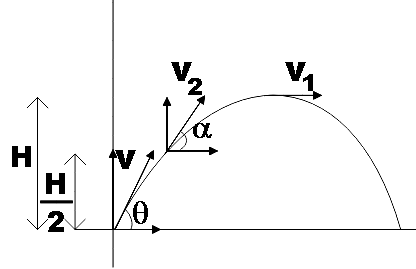
Answer
431.7k+ views
Hint: As a first step, you could make a rough diagram of the projectile motion under discussion. Then, you could consider the motion part by part. You could apply Newton’s equation of motion for the case of motion from 0 to H and H to$\dfrac{H}{2}$ separately. Now using those relations along with the given conditions we will get the angle of the projectile.
Formula used:
Equation of motion,
${{v}^{2}}-{{u}^{2}}=2as$
Complete answer:
In the question, we are given the speed of a projectile at the highest point as ${{v}_{1}}$ and at the point that is half the maximum height be${{v}_{2}}$. We are given that,
$\dfrac{{{v}_{1}}}{{{v}_{2}}}=\sqrt{\dfrac{2}{5}}$…………………………………………. (1)
We are supposed to find the angle of projection.

We know that at the highest point the vertical component of velocity is zero. Also, for a projectile motion, the horizontal component of velocity remains the same, that is,
$v\cos \theta ={{v}_{2}}\cos \alpha ={{v}_{1}}$
$\Rightarrow \dfrac{{{v}_{1}}}{{{v}_{2}}}=\cos \alpha =\sqrt{\dfrac{2}{5}}$ ………………………………………. (2)
Now, we could consider the motion from$\dfrac{H}{2}$ to $H$,
Let us recall the Newton’s equation of motion,
${{v}^{2}}-{{u}^{2}}=2as$
$\Rightarrow {{v}_{1y}}^{2}-{{v}_{2y}}^{2}=2{{a}_{y}}s$
$\Rightarrow 0-\left( {{v}_{2}}^{2}{{\sin }^{2}}\alpha \right)=2\left( -g \right)\dfrac{H}{2}$
$\Rightarrow {{v}_{2}}^{2}\left( 1-{{\cos }^{2}}\alpha \right)=gH$
From (2),
$\Rightarrow {{v}_{2}}^{2}\left( 1-\dfrac{2}{5} \right)=gH$
$\therefore {{v}_{2}}=\sqrt{\dfrac{5}{3}}gH$ ……………………………………….. (3)
Now from (1),
$\dfrac{{{v}_{1}}}{{{v}_{2}}}=\sqrt{\dfrac{2}{5}}$
$\Rightarrow {{v}_{1}}={{v}_{2}}\times \sqrt{\dfrac{2}{5}}$
$\Rightarrow {{v}_{1}}=\sqrt{\dfrac{5}{3}}gH\times \sqrt{\dfrac{2}{5}}$
$\therefore {{v}_{1}}=\sqrt{\dfrac{2}{3}}gH$
Similarly, for the motion from 0 to H, we have,
${{v}_{{{1}_{y}}}}^{2}-{{\left( v\sin \theta \right)}^{2}}=2\left( -g \right)H$
$\Rightarrow {{v}^{2}}{{\sin }^{2}}\theta =2gH$
$\Rightarrow \dfrac{{{v}_{1}}^{2}}{{{\cos }^{2}}\theta }{{\sin }^{2}}\theta =2gH$
$\dfrac{2}{3}gH{{\tan }^{2}}\theta =2gH$
$\Rightarrow {{\tan }^{2}}\theta =3$
$\Rightarrow \tan \theta =\sqrt{3}$
$\therefore \theta =60{}^\circ $
Therefore, we found that the angle of the projectile in the given question is found to be $60{}^\circ $ .
Hence, option D is found to be the correct answer.
Note:
We have assigned negative signs for the acceleration of the projectile, because we have chosen the convention in such a way. For questions like this you could consider the motion related to each point mentioned in the question. Doing so, you will easily solve the problem and also avoid confusions.
Formula used:
Equation of motion,
${{v}^{2}}-{{u}^{2}}=2as$
Complete answer:
In the question, we are given the speed of a projectile at the highest point as ${{v}_{1}}$ and at the point that is half the maximum height be${{v}_{2}}$. We are given that,
$\dfrac{{{v}_{1}}}{{{v}_{2}}}=\sqrt{\dfrac{2}{5}}$…………………………………………. (1)
We are supposed to find the angle of projection.

We know that at the highest point the vertical component of velocity is zero. Also, for a projectile motion, the horizontal component of velocity remains the same, that is,
$v\cos \theta ={{v}_{2}}\cos \alpha ={{v}_{1}}$
$\Rightarrow \dfrac{{{v}_{1}}}{{{v}_{2}}}=\cos \alpha =\sqrt{\dfrac{2}{5}}$ ………………………………………. (2)
Now, we could consider the motion from$\dfrac{H}{2}$ to $H$,
Let us recall the Newton’s equation of motion,
${{v}^{2}}-{{u}^{2}}=2as$
$\Rightarrow {{v}_{1y}}^{2}-{{v}_{2y}}^{2}=2{{a}_{y}}s$
$\Rightarrow 0-\left( {{v}_{2}}^{2}{{\sin }^{2}}\alpha \right)=2\left( -g \right)\dfrac{H}{2}$
$\Rightarrow {{v}_{2}}^{2}\left( 1-{{\cos }^{2}}\alpha \right)=gH$
From (2),
$\Rightarrow {{v}_{2}}^{2}\left( 1-\dfrac{2}{5} \right)=gH$
$\therefore {{v}_{2}}=\sqrt{\dfrac{5}{3}}gH$ ……………………………………….. (3)
Now from (1),
$\dfrac{{{v}_{1}}}{{{v}_{2}}}=\sqrt{\dfrac{2}{5}}$
$\Rightarrow {{v}_{1}}={{v}_{2}}\times \sqrt{\dfrac{2}{5}}$
$\Rightarrow {{v}_{1}}=\sqrt{\dfrac{5}{3}}gH\times \sqrt{\dfrac{2}{5}}$
$\therefore {{v}_{1}}=\sqrt{\dfrac{2}{3}}gH$
Similarly, for the motion from 0 to H, we have,
${{v}_{{{1}_{y}}}}^{2}-{{\left( v\sin \theta \right)}^{2}}=2\left( -g \right)H$
$\Rightarrow {{v}^{2}}{{\sin }^{2}}\theta =2gH$
$\Rightarrow \dfrac{{{v}_{1}}^{2}}{{{\cos }^{2}}\theta }{{\sin }^{2}}\theta =2gH$
$\dfrac{2}{3}gH{{\tan }^{2}}\theta =2gH$
$\Rightarrow {{\tan }^{2}}\theta =3$
$\Rightarrow \tan \theta =\sqrt{3}$
$\therefore \theta =60{}^\circ $
Therefore, we found that the angle of the projectile in the given question is found to be $60{}^\circ $ .
Hence, option D is found to be the correct answer.
Note:
We have assigned negative signs for the acceleration of the projectile, because we have chosen the convention in such a way. For questions like this you could consider the motion related to each point mentioned in the question. Doing so, you will easily solve the problem and also avoid confusions.
Recently Updated Pages
Fill in the blanks with suitable prepositions Break class 10 english CBSE

Fill in the blanks with suitable articles Tribune is class 10 english CBSE

Rearrange the following words and phrases to form a class 10 english CBSE

Select the opposite of the given word Permit aGive class 10 english CBSE

Fill in the blank with the most appropriate option class 10 english CBSE

Some places have oneline notices Which option is a class 10 english CBSE

Trending doubts
Fill the blanks with the suitable prepositions 1 The class 9 english CBSE

How do you graph the function fx 4x class 9 maths CBSE

When was Karauli Praja Mandal established 11934 21936 class 10 social science CBSE

Which are the Top 10 Largest Countries of the World?

What is the definite integral of zero a constant b class 12 maths CBSE

Why is steel more elastic than rubber class 11 physics CBSE

Distinguish between the following Ferrous and nonferrous class 9 social science CBSE

The Equation xxx + 2 is Satisfied when x is Equal to Class 10 Maths

Differentiate between homogeneous and heterogeneous class 12 chemistry CBSE




